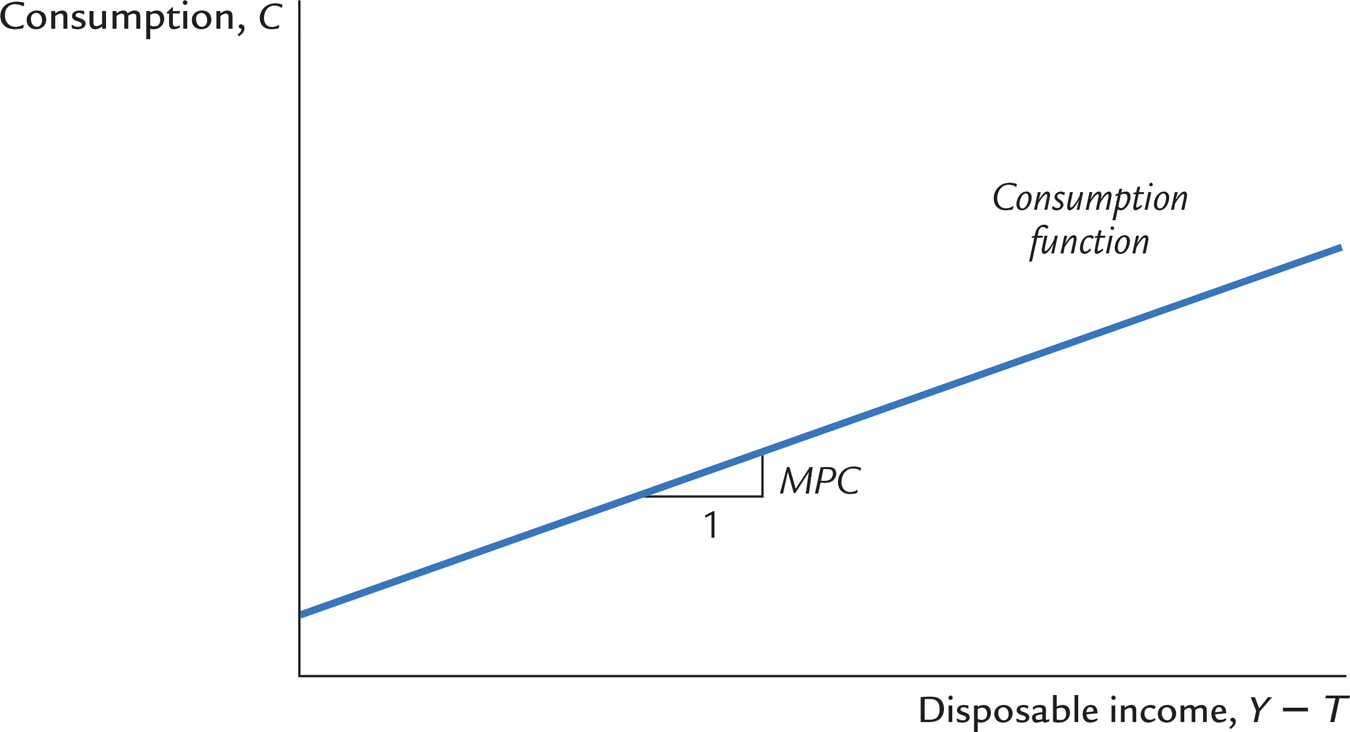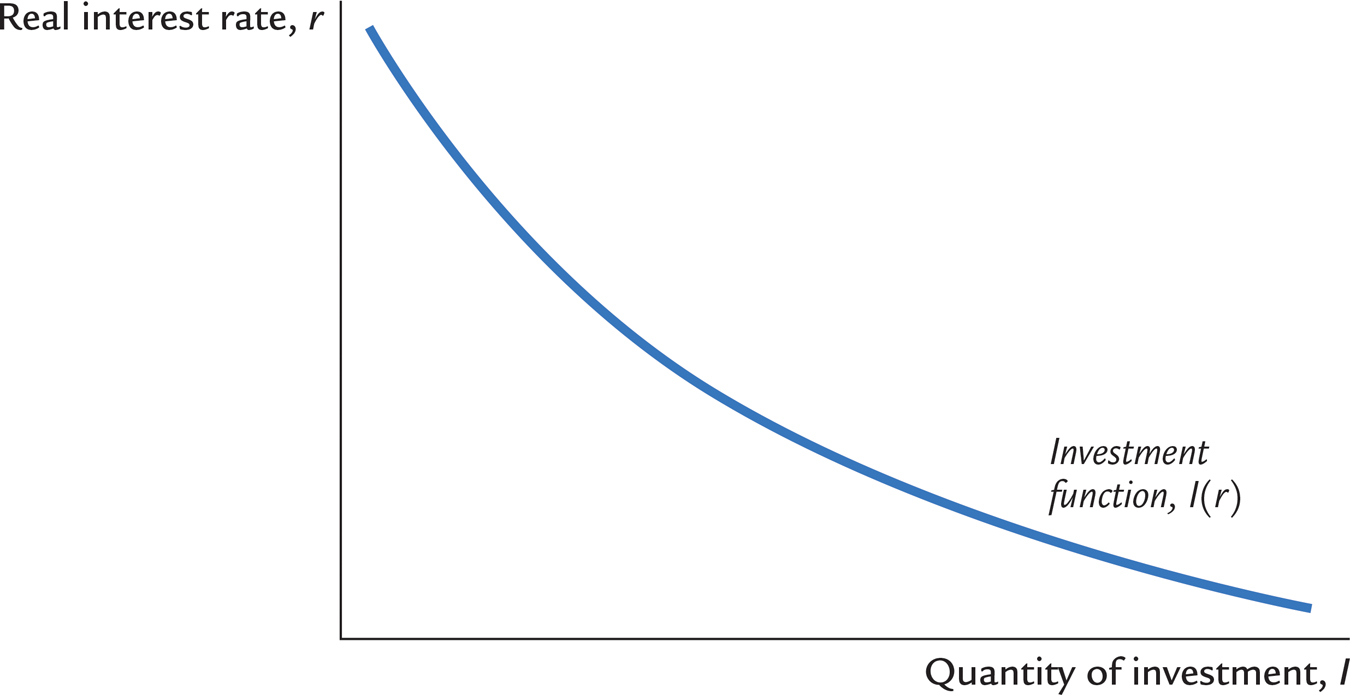3.3 What Determines the Demand for Goods and Services?
We have seen what determines the level of production and how the income from production is distributed to workers and owners of capital. We now continue our tour of the circular flow diagram, Figure 3-1, and examine how the output from production is used.
In Chapter 2 we identified the four components of GDP:
Consumption (C)
Investment (I)
Government purchases (G)
Net exports (NX).
The circular flow diagram contains only the first three components. For now, to simplify the analysis, we assume our economy is a closed economy—a country that does not trade with other countries. Thus, net exports are always zero. (We examine the macroeconomics of open economies in Chapter 6.)
A closed economy has three uses for the goods and services it produces. These three components of GDP are expressed in the national income accounts identity:
Y = C + I + G.
Households consume some of the economy’s output, firms and households use some of the output for investment, and the government buys some of the output for public purposes. We want to see how GDP is allocated among these three uses.
Consumption
When we eat food, wear clothing, or go to a movie, we are consuming some of the output of the economy. All forms of consumption together make up about two-
66
Households receive income from their labor and their ownership of capital, pay taxes to the government, and then decide how much of their after-
We assume that the level of consumption depends directly on the level of disposable income. A higher level of disposable income leads to greater consumption. Thus,
C = C(Y − T).
This equation states that consumption is a function of disposable income. The relationship between consumption and disposable income is called the consumption function.
The marginal propensity to consume (MPC) is the amount by which consumption changes when disposable income increases by one dollar. The MPC is between zero and one: an extra dollar of income increases consumption, but by less than one dollar. Thus, if households obtain an extra dollar of income, they save a portion of it. For example, if the MPC is 0.7, then households spend 70 cents of each additional dollar of disposable income on consumer goods and services and save 30 cents.
Figure 3-7 illustrates the consumption function. The slope of the consumption function tells us how much consumption increases when disposable income increases by one dollar. That is, the slope of the consumption function is the MPC.

67
Investment
Both firms and households purchase investment goods. Firms buy investment goods to add to their stock of capital and to replace existing capital as it wears out. Households buy new houses, which are also part of investment. Total investment in the United States averages about 15 percent of GDP.
The quantity of investment goods demanded depends on the interest rate, which measures the cost of the funds used to finance investment. For an investment project to be profitable, its return (the revenue from increased future production of goods and services) must exceed its cost (the payments for borrowed funds). If the interest rate rises, fewer investment projects are profitable, and the quantity of investment goods demanded falls.
For example, suppose a firm is considering whether it should build a $1 million factory that would yield a return of $100,000 per year, or 10 percent. The firm compares this return to the cost of borrowing the $1 million. If the interest rate is below 10 percent, the firm borrows the money in financial markets and makes the investment. If the interest rate is above 10 percent, the firm forgoes the investment opportunity and does not build the factory.
The firm makes the same investment decision even if it does not have to borrow the $1 million but rather uses its own funds. The firm can always deposit this money in a bank or a money market fund and earn interest on it. Building the factory is more profitable than depositing the money if and only if the interest rate is less than the 10 percent return on the factory.
A person wanting to buy a new house faces a similar decision. The higher the interest rate, the greater the cost of carrying a mortgage. A $100,000 mortgage costs $6,000 per year if the interest rate is 6 percent and $8,000 per year if the interest rate is 8 percent. As the interest rate rises, the cost of owning a home rises, and the demand for new homes falls.
When studying the role of interest rates in the economy, economists distinguish between the nominal interest rate and the real interest rate. This distinction is relevant when the overall level of prices is changing. The nominal interest rate is the interest rate as usually reported: it is the rate of interest that investors pay to borrow money. The real interest rate is the nominal interest rate corrected for the effects of inflation. If the nominal interest rate is 8 percent and the inflation rate is 3 percent, then the real interest rate is 5 percent. In Chapter 5 we discuss the relation between nominal and real interest rates in detail. Here it is sufficient to note that the real interest rate measures the true cost of borrowing and, thus, determines the quantity of investment.
We can summarize this discussion with an equation relating investment I to the real interest rate r:
I = I(r).
Figure 3-8 shows this investment function. It slopes downward, because as the interest rate rises, the quantity of investment demanded falls.

68
FYI
The Many Different Interest Rates
If you look in the business section of a newspaper or on a financial Web site, you will find many different interest rates reported. By contrast, throughout this book, we will talk about “the” interest rate, as if there were only one interest rate in the economy. The only distinction we will make is between the nominal interest rate (which is not corrected for inflation) and the real interest rate (which is corrected for inflation). Almost all of the interest rates reported by financial news organizations are nominal.
Why are there so many interest rates? The various interest rates differ in three ways:
Term. Some loans in the economy are for short periods of time, even as short as overnight. Other loans are for thirty years or even longer. The interest rate on a loan depends on its term. Long-
term interest rates are usually, but not always, higher than short- term interest rates. Credit risk. In deciding whether to make a loan, a lender must take into account the probability that the borrower will repay. The law allows borrowers to default on their loans by declaring bankruptcy. The higher the perceived probability of default, the higher the interest rate. Because the government has the lowest credit risk, government bonds tend to pay a low interest rate. At the other extreme, financially shaky corporations can raise funds only by issuing junk bonds, which pay a high interest rate to compensate for the high risk of default.
Tax treatment. The interest on different types of bonds is taxed differently. Most important, when state and local governments issue bonds, called municipal bonds, the holders of the bonds do not pay federal income tax on the interest income. Because of this tax advantage, municipal bonds pay a lower interest rate.
When you see two different interest rates reported, you can almost always explain the difference by considering the term, the credit risk, and the tax treatment of the loan.
Although there are many different interest rates in the economy, macroeconomists often ignore these distinctions because the various interest rates tend to move up and down together. For many purposes, we will not go far wrong by assuming there is only one interest rate.
69
Government Purchases
Government purchases are the third component of the demand for goods and services. The federal government buys guns, missiles, and the services of government employees. Local governments buy library books, build schools, and hire teachers. Governments at all levels build roads and other public works. All these transactions make up government purchases of goods and services, which account for about 20 percent of GDP in the United States.
These purchases are only one type of government spending. The other type is transfer payments to households, such as public assistance for the poor and Social Security payments for the elderly. Unlike government purchases, transfer payments are not made in exchange for some of the economy’s output of goods and services. Therefore, they are not included in the variable G.
Transfer payments do affect the demand for goods and services indirectly. Transfer payments are the opposite of taxes: they increase households’ disposable income, just as taxes reduce disposable income. Thus, an increase in transfer payments financed by an increase in taxes leaves disposable income unchanged. We can now revise our definition of T to equal taxes minus transfer payments. Disposable income, Y − T, includes both the negative impact of taxes and the positive impact of transfer payments.
If government purchases equal taxes minus transfers, then G = T and the government has a balanced budget. If G exceeds T, the government runs a budget deficit, which it funds by issuing government debt—
Here we do not try to explain the political process that leads to a particular fiscal policy—

We do, however, want to examine the impact of fiscal policy on the endogenous variables, which are determined within the model. The endogenous variables here are consumption, investment, and the interest rate.
To see how the exogenous variables affect the endogenous variables, we must complete the model. This is the subject of the next section.